 Start Voyager 2 August 20, 1977
Start Voyager 2 August 20, 1977Today marks 40 years since the launch of Voyager 1, while his twin brother Voyager 2 celebrated his anniversary 16 days earlier. Using a unique
parade of giant planets (occurring once in
175 years ), they managed to turn our understanding of the Solar System, and make as many discoveries as no one could make before or after them.
They account for: the detection of the first lightning and the first volcano outside the Earth; the discovery of the first
cryovolcano , and the only object in the solar system (with the exception of the Earth), on the surface of which liquid seas may exist; discovery of 3 moons of Jupiter, 4 moons of Saturn, 11 moons of Uranus and 6 moons of Neptune; determination of the record holders of the Solar system: by the strength of the magnetic field, the speed of the winds, the surface
albedo , the mass among the satellites; discovery of the shock wave and heliopause boundaries near the solar heliosphere.
Without exaggeration, it can be said that these two devices showed us that the Solar system is not as lifeless as we thought. And they paved the way for the Pleiad of new vehicles, which went to study what the Voyagers did not fully study.
Prehistory
In the summer of 1961, a postgraduate student at the University of California at Los Angeles,
Michael Minovich, began a search for a solution
to the three-body problem . He used for this purpose the university-owned
IBM 7090 , the most powerful computer that existed at that time. By the end of the summer, he was able to establish that under certain conditions of meeting with the planet, the spacecraft gets an increase in speed, and with others it loses it. During the internship at the
Jet Propulsion Laboratory (hereinafter referred to as JPL) in the summer of next year, he persuaded his boss to give him more accurate data on the positions of the planets, and his calculations were confirmed.
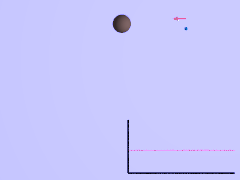
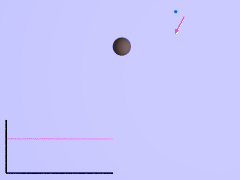
This discovery made Mercury and
the giant planets available for research by the imperfect technology existing at that time (at that time the satellite era was just beginning, and NASA could not guarantee the work of scientific devices for more than a few months, so the giant planets were considered out of reach). However, JPL at that moment was intensely preparing for the Apollo program, and its discovery did not receive due attention. But already 10 years later, the calculations made by him in 1963 would form the basis of the missions of Mariner-10 (which completed the second gravitational maneuver after the Moon-3) and the Pioneer-10 and 11 vehicles (for the first time crossed the asteroid belt).
In the summer of 1964, another JPL intern,
Gary Flandro , became interested in the Minovich idea, and he began to look for practical applications for this idea. He began to draw graphs of the future position of the planets and soon discovered that at the end of the 70s all the planets behind the asteroid belt (including Pluto then) should have gathered in a narrow sector of the sky. This gave a unique opportunity “jumping” from one planet to another with the help of gravitational maneuvers, to study them all at once (at the same time reducing the flight time from 13 to 8 years, which increased the chances of success).
Such a chance could not be missed, and Minovic, with the support of presidential space policy adviser
Maxwell Hunter, was able to convince NASA to establish the
Big Journey program , which involved the launch of six vehicles at once on the Jupiter-Saturn-Pluto and Uranus-Neptune-Pluto routes. Unfortunately, this ambitious project did not come true: the overall budget cuts by NASA (which was well underway at the close of the Apollo program) also hit this project.
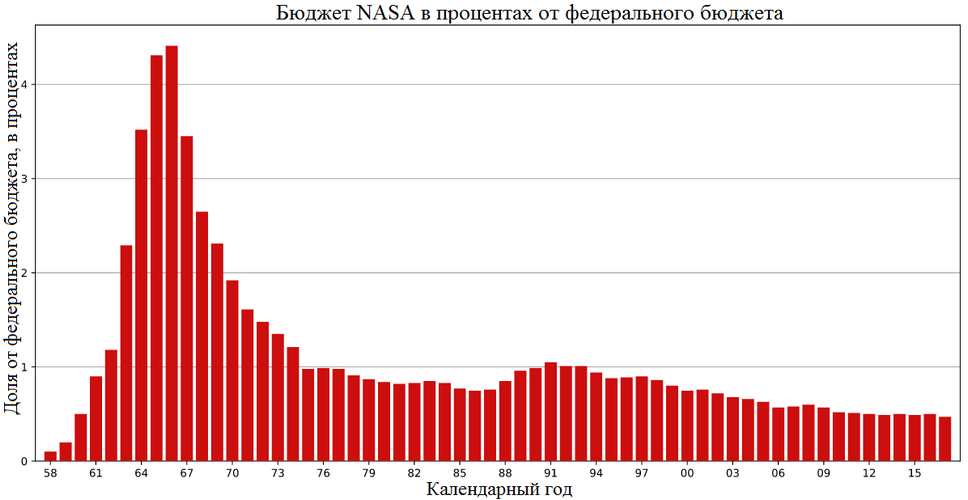
As a result, on July 1, 1972, the preference was given to three times cheaper project Mariner-Jupiter-Saturn 77, in which only three vehicles remained. And in 1975, the Voyager-3 mission to Jupiter and Uranus was also canceled. Thus, the references to Uranus, Neptune and Pluto were completely removed from the program, and the duration of the program was reduced to 5 years.
However, NASA went to the trick: although both vehicles were officially intended solely for the study of Jupiter, Saturn and his companion Titan, the developers of the devices initially designed them with the expectation that they would be able to get to the distant planets in working order: the Voyager-1 trajectory allowed already in the course of the flight, to choose between the studies of Titan or Pluto, and Voyager-2, which insured it, in case the fellow worked out his research program without failures, could go to a meeting with Uranus and Neptune. In the course of preparing the program, 10 thousand possible trajectories were considered before two of them became approved apparatus trajectories.

December 13-15, 1972 - the first scientific meeting on the project.
In December 1972, flying past Jupiter, Pioneer-10 got a computer crash, during which Io's pictures taken at close range were lost; In addition, the device received a darkening of the sensors of asteroids and meteorites. The cause of these damages were the radiation belts of Jupiter, which turned out to be 1 million times more powerful than the earth ones. The developers faced an acute problem of the radiation protection of the devices, with which (as we now know) they coped remarkably well. Already in March 1977 (six months before the launch of the devices), it was decided to replace the name Mariner-Jupiter-Saturn 77 (officially called
MSJ-77 ) with something more harmonious. In this way, Voyagers appeared.
Device design
Nowadays, the capabilities of the devices can only cause a smile, but at the time of their creation they were the pinnacle of engineering: they were the first to use extensively the means of protection against radiation and electrostatic discharges; they first had an automatic crash protection system and programmable electronics in the orientation system; they became the first "space" application of Reed-Solomon codes and technology of combining individual radio antennas into arrays for communication with spacecraft. Each device contains about 65 thousand parts, and the computers inside the devices contain about 5 million electronic components. On the construction of two Voyagers took 5 years of work about 1.5 thousand engineers, and about $ 200 million.
In terms of communications, the devices have always been at the forefront: it was to speed up communication with them that the radio antennas of
the NASA long-distance space communications network (hereinafter referred to as DSN), which are now used in all NASA research projects outside the earth orbit, were modernized. In fact, they became the “godfathers” of most research projects on objects outside the asteroid belt, both in terms of communications and in the scientific justification of future projects.
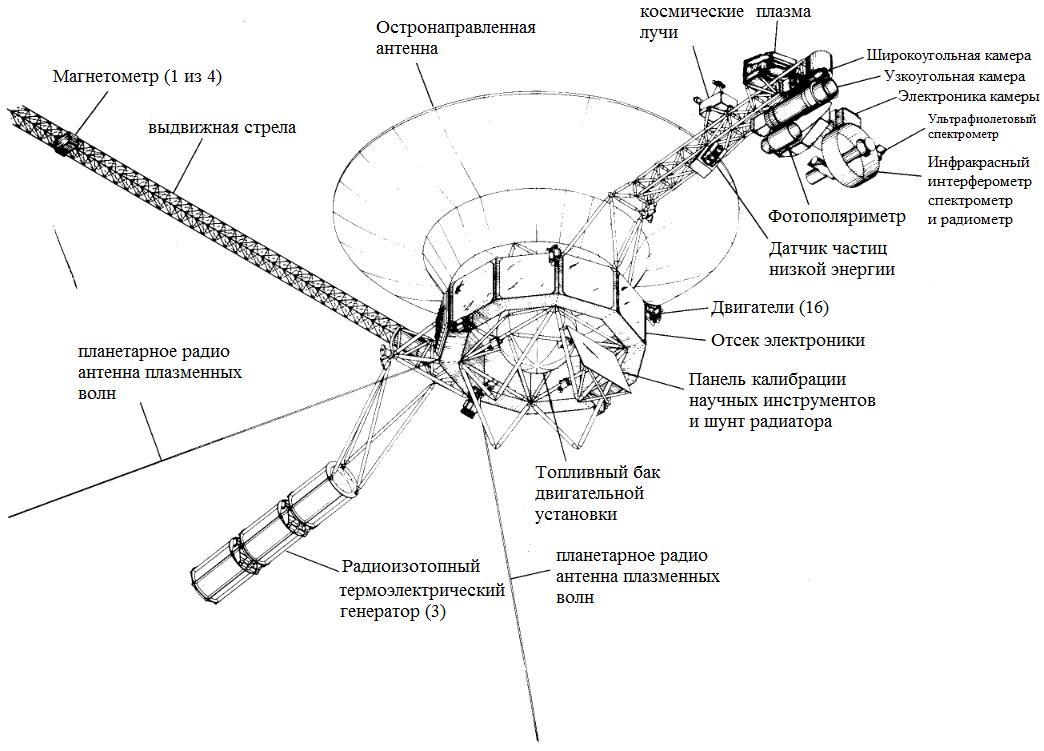 Communication system:
Communication system: since the developers initially expected that their devices should reach the far borders of the solar system, antennas occupy a key place in the devices: their diameter is 3.66 m, and they themselves consist of an aluminum core coated with a mixture of graphite and epoxy resin.
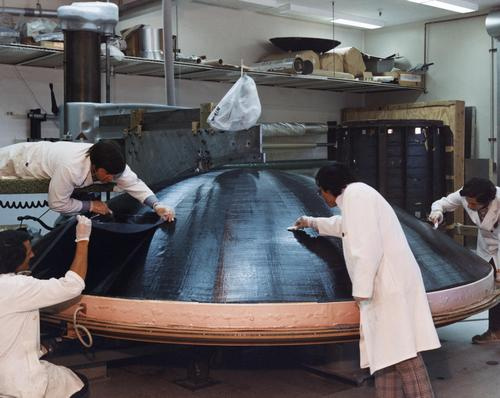

Commands from the Earth are transmitted in the
S-radio band to one of two duplicate receivers, and for transmitting data to the Earth,
X-band transmitters are also used. One S-transmitter and both X-transmitters use
traveling-wave tubes as an amplifier. The power of the amplifiers is 9.4 and 21.3 W, while only one of the receivers or transmitters can operate at a time.
Initially, the communication system was designed for a transfer rate of 115.2 kbit / s in Jupiter, and 44.8 kbit / s in Saturn with a bit error probability of 5 * 10
-3 (which was provided by the
Reed-Solomon correction codes). For communication with Uranus and Neptune - the communication speed dropped further, and for the transfer of images it took compression, so errors in data transmission became even more critical, and convolutional codes
were added over the Reed-Solomon codes (this provided the probability of bit errors 10
-6 with a small increasing computational complexity).
The energy source consisted of three
MHW thermoelectric generators (similar were used only on
LES 8/9 satellites) and 40.6 cm in diameter with a length of 51 cm. The weight of each of them is 37.7 kg (including about 4.5 kg plutonium-238), and the power was more than 156 W at the start (at about 2.4 kW of heat).
Appearance:
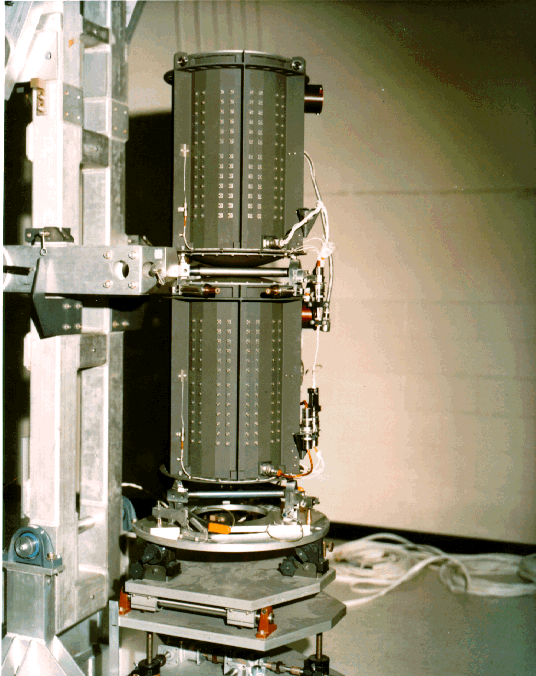
And design:
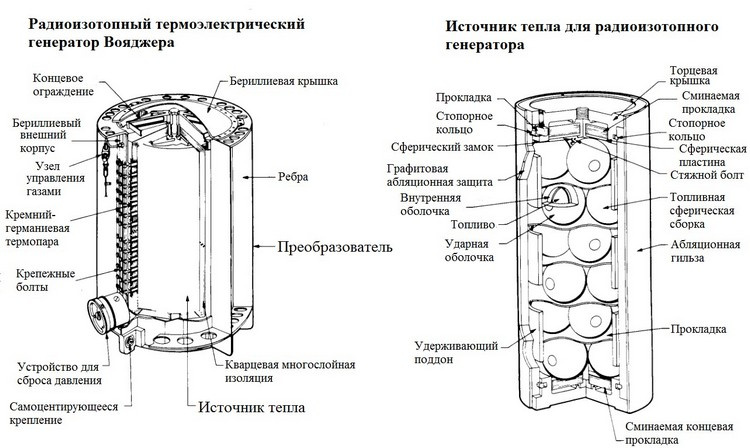 The orientation system
The orientation system includes 16 one-component orientation engines (working on hydrazine decomposition) with a load of only 85 grams each; three gyros with an accuracy of one ten thousandth of a degree (one of which was a spare);
Canopus and Sun sensors (which were located in the antenna hole):
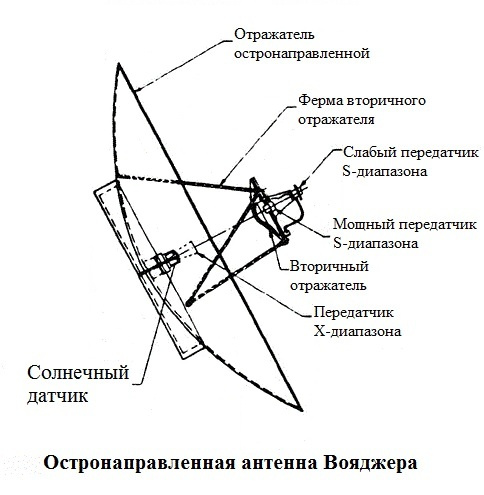 A computer
A computer consists of three separate duplicated computers. The first of them (CCS) performs a command role, and monitors the state of the apparatus (it is identical to that used in
the Viking program ); the other (Flight Data System - FDS) performs the tasks of forming and transmitting telemetry (it was designed specifically for the devices); and the third (Attitude and Articulation Control System - AACS) controls the orientation system and the platform with scientific instruments.
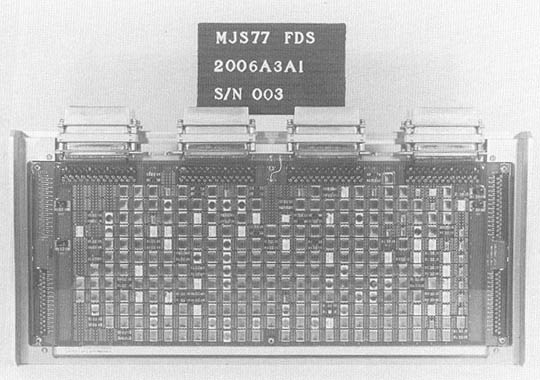
"64
0 kilobytes is enough for everyone" the developers thought, and made the operating memory of the devices consisting of 4 thousand 18-bit words (approximately 69.63 Kbytes). The master oscillator of the processor operates at 4 MHz, but the clock frequency of the processor itself is only 250 kHz, while it can only perform 8 thousand operations per second. At the time of the launch of the devices from the available 4 thousand words -
only two remained free, but when Uranus and Neptune were flown - the situation became even more aggravated, since it was necessary to cram more code into this volume to correct the rotational irregularities of the Voyager-2 platform.
Recording device: it is a tape recorder with a belt drive, and a magnetic tape half an inch wide (12.7 mm) and 328 m long. The width of the tape is divided into 8 strips, from which only one can be read at a time. The total amount of memory is 536 million bits (about 63.9 MB) - this is enough to record 100 photos from television cameras. The write speed is 115.2 and 7.2 kbps, and the read rate is 57.6; 33.6; 21.6 and 7.2 kbps.
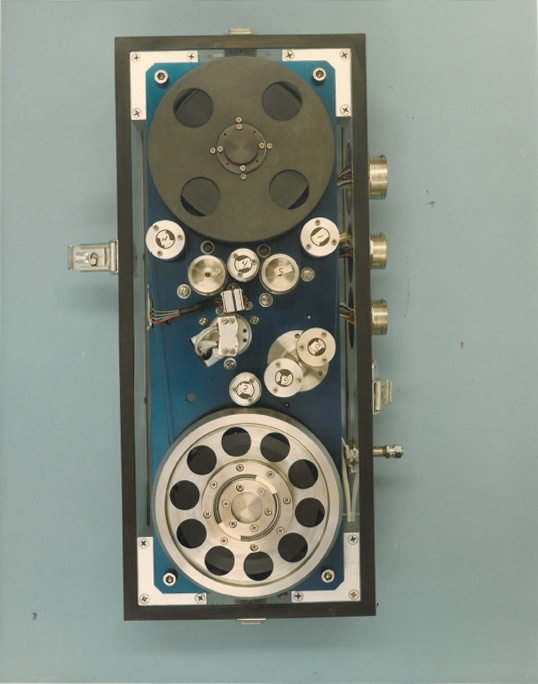 Software:
Software: stored in rewritable memory, and this opportunity was used during the mission countless times, both to improve performance and to correct failures. Initially, all the code for the devices was written to Fortran 5, then it was ported to Fortran 77, and at the moment - part of it is transferred to C, while the other part remains on Fortran. Devices have 7 subroutines responsible for correcting a variety of possible failures. After the passage of Neptune in 1990, the code was rewritten so that the devices continued to transmit data back, even if the devices could not receive commands from Earth.
Scientific equipment: included 11 instruments weighing 105 kg, most of which are placed on a platform 2.3 m long, on the side opposite to the
RTG (to protect it from radiation). The total weight of the rotating platform is 103 kg, and its positioning accuracy is above one-tenth of a degree. The engine of the platform rotates at a ratio of 1/9000, so that already by the span of Neptune, he made 5 million revolutions in 12 years - without failures and any maintenance.
On the devices there are two cameras of narrow and wide viewing angle (3 ° and 0.4 °) with a resolution of 800 lines. At the same time, the sharpness of the narrow-angle camera is sufficient for reading a newspaper from a distance of 1 km. Magnetometers of high and low sensitivity are placed on a fiberglass boom 13 meters long (designed to study the magnetic fields of planets and the solar wind); their positioning accuracy is 2 °.
Infrared and ultraviolet spectrometers (for measuring temperature and atmospheric composition), photopolarimeter (for measuring texture, and atmospheric density), plasma spectrometer (for measuring ions and electrons in the environment), detector of low-energy charged particles (for measuring the direction of movement of ions and electrons ), a plasma wave receiver (for measuring density, and waves in the surrounding plasma), a cosmic ray detector, and a system using a standard apparatus communication system to study the environment between the devices and the Earth. As well as the radio, which were made
"Symphony of the Planets .
"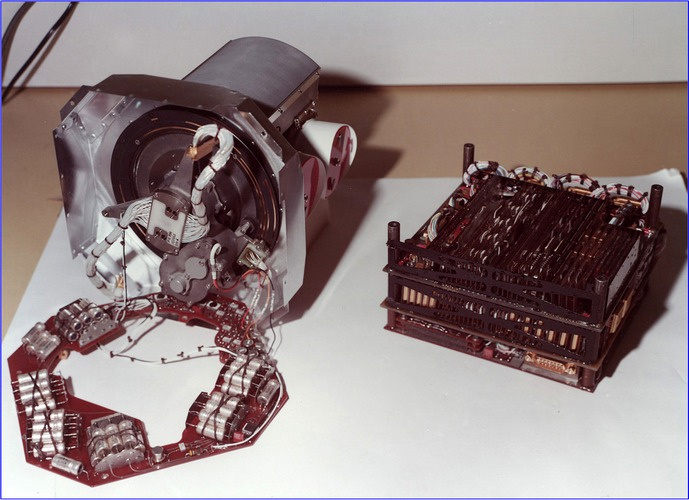
Low energy charged particle detector: it includes a stepper motor, allowing the detector to rotate 360 °. It was tested on 500 thousand steps (so that it could reach Saturn), now it has completed them for more than 6 million steps.
Gold records : recordings of compositions by Beethoven, Mozart, Stravinsky and
Blind Willie Johnson are located on them (the general list is
here , and you can listen to them
here ); 116 images of the Earth, people and animals; recording the sounds of wind, thunder, singing of some birds and animals; Greetings in 55 languages and Jimmy Carter’s address (who was then president of the United States); as well as the position of our solar system relative to 14 pulsars. On the reverse side there is an instruction on how to listen to these recordings.
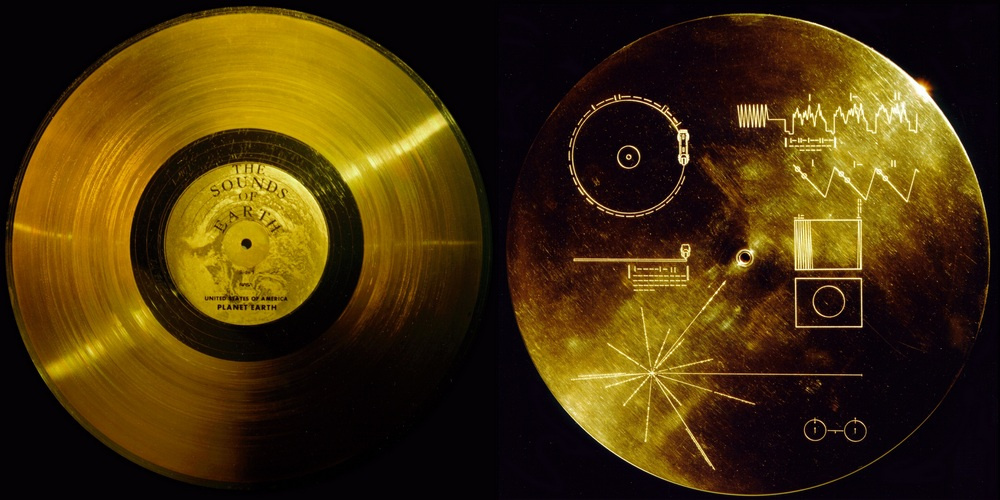 The front side with the records, and the reverse with the instruction
The front side with the records, and the reverse with the instructionRunning ... and the first problems
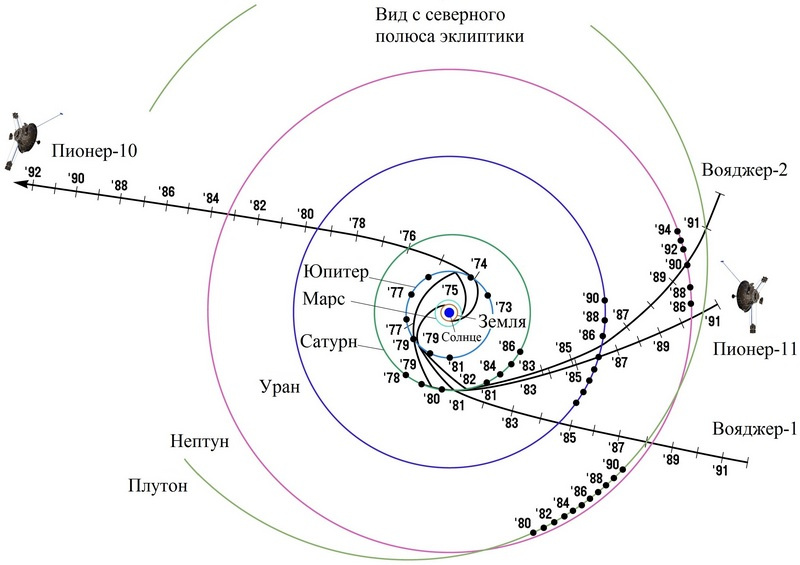
The launch of the Voyagers demanded the use of the most powerful of the NASA missiles existing at that time: the five-speed 633 ton carrier rocket
Titan IIIE , which worked on 4 different fuel components: the accelerator and the second booster unit were solid propellant (but with different composition), the first and second the stages were filled with aerosine and diazotote tetroxide, and the role of the third stage was performed by the oxygen-hydrogen accelerating unit
"Centaurus" .
Few people know that the whole mission could have ended in a huge fiasco, even in the first month. When Voyager-2 started, the first 4 steps worked perfectly: the booster according to plan worked for 468 seconds, and the “Centaurus” that started 4 seconds after it separated from it, after working for 101 seconds, put the device into a parking orbit. After 43 minutes, he turned on again, and after working for 339 seconds, he switched the solid-fuel accelerating block
Star-37E with Voyager-2 to the departure trajectory. Then, the Voyager-2 on-board computer came into operation, which turned on the upper stage, which worked for 89 seconds, and brought the device to the trajectory of a meeting with Jupiter.
But the separation of Voyager-2 and Star-37E, followed by disclosure of the rods of the apparatus did not go as smoothly as we would like: immediately after these manipulations, the apparatus began to rotate, and 16 seconds after the division of the main AACS, it refused to work at all (since both CCS transferred he is simultaneously a team for the preparation of orientation engines). This ultimately saved the unit, since the second AACS had no information from the gyroscopes, and it started the orientation from scratch. It was possible to carry out the orientation, but it took 3.5 hours, and the problems did not end there: the instrumentation data said that one of the rods was not fully revealed. It was decided to push the barbell so that it would lock, using the orientation device's reversal of the apparatus, together with shooting the lid of the IRIS spectrometer, but Voyager-2 computer canceled this command, finding it dangerous. By September 1, it was still possible to establish that the boom was actually in place, and to carry out initial checks after it, so the Voyagers team had several days of respite between translating Voyager-2 into hibernation and starting Voyager-1.
At the start of Voyager-1, on the contrary, the separation and operation of the accelerating units was impeccable, but the oxidant leakage at the second stage of Titan IIIE caused it to shut down before it was laid, and the launch vehicle did not reach the Centaurus as much as 165.8 m / s. The computer of the upper stage identified the malfunction and extended the operation time when entering the parking orbit. But for the second fuel switch-on, the overclocking unit was enough butt: at the time of the engine shutdown, there was only
3.4 seconds of fuel left in the Centaurus. If Voyager-2 flew on this rocket - the upper stage would shut down without gaining the necessary speed (when departing from Earth, Voyager-2 speed should have been 15.2 km / s, while Voyager-1 speed was only 15, 1 km / s).
On September 18, during the calibration of instruments, Voyager-1 made a joint photo of the Earth and the Moon in one frame (
for the first time among automatic devices), the distance to the Earth was already 11.66 million km:

On December 10, both vehicles entered the
asteroid belt , and 9 days later (still inside it) Voyager-1 overtook Voyager-2, on the way to their first common goal (this was due to the flatter trajectory of the Voyager-1 flight). Thus, he had already reached Jupiter before his colleague, and knowing this, the creators of the devices went on such a strange numbering.
On February 23, 1978, the Voyager-1 turntable stuck in one position. On March 17, this malfunction was overcome with the help of careful platform movements back and forth.
In the summer of 1978, Voyager-2 was forgotten several times to transmit a test signal, and a week later (when the counter came to an end), the device considered the primary transmitter to be out of order, and switched to a spare one. Noticing this, the operators gave the device a command to switch to the main transmitter, but the device stopped altogether: during the switching of the transmitters, a short circuit occurred, and both fuses on the main transmitter failed. The second transmitter was lucky a little more: the coupling capacitor (responsible for the frequency control) went out of operation, but it remained operational.
From now on and until now - to communicate with Voyager-2, it is necessary to calculate the exact frequency of signal transmission taking into account the speed of the vehicle’s movement, the Earth’s motion around the Sun and even the temperature of the receiving device itself inside the device (since its unaccounted change is only 0.25 ° C leads to the fact that communication with the device disappears).
Approach to Jupiter
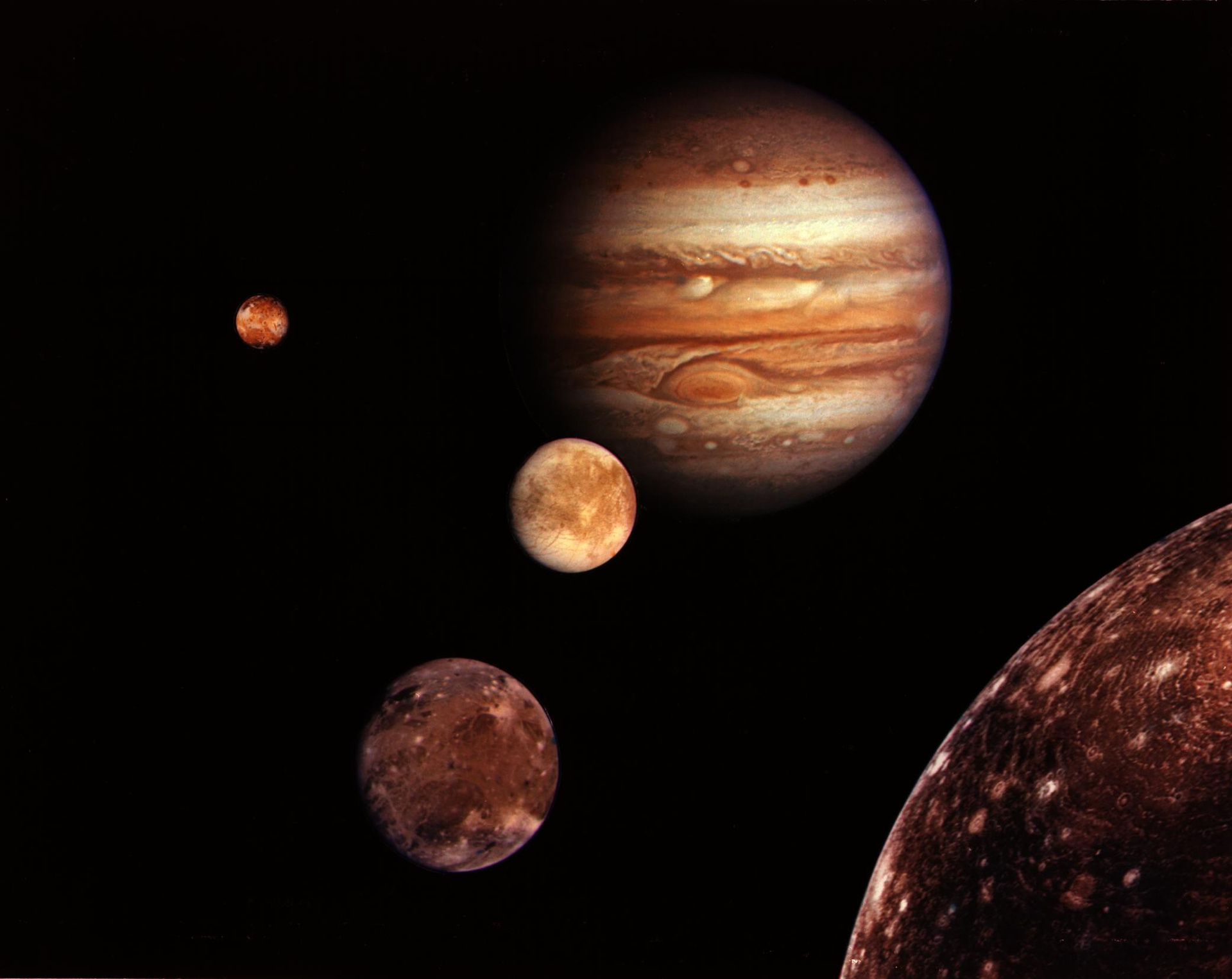
The signal delay during the communication of devices during the flight of Jupiter should have been 38 minutes, so it was necessary to prepare everything in advance: if scientists would have made a mistake in some fractions of a degree in the camera position, the device would have removed endless space, instead of Jupiter and its satellites. So, the software update for sharpening the image was uploaded to the devices at the end of August 1978, and the flight program of the devices was compiled several days in advance.
Voyager 1 began to take the first pictures of Jupiter on January 6, 1979, with an interval of 2 hours, and their resolution immediately exceeded the resolution of all available photos of Jupiter at that time. From January 30, the device switched to photographing with an interval of 96 seconds, and on February 3, it began to take 2x2 mosaic images (since the size of Jupiter became larger than the camera
resolution ).
From February 21, he switched to a 3x3 mosaic, and the closest approach to Jupiter occurred on March 5.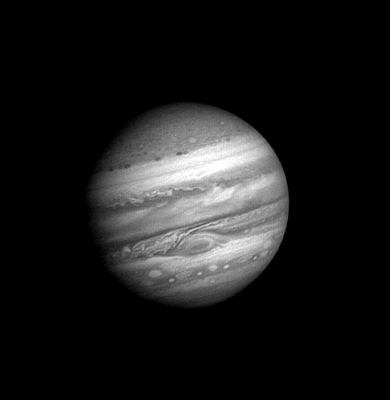 Pictures of Jupiter with an interval of one Jupiter's day (10 hours) taken from January 6 to February 3, 1979 by Voyager-1.In addition to pictures of Jupiter, Voyager-1 took pictures of his rings and satellites, among which there was an amazing variety of surfaces. From February 27, JPL daily press conferences began, presenting new discoveries to the press. They ended only on March 6, when when it was officially announced that Voyager 1 had flown by Jupiter.
Pictures of Jupiter with an interval of one Jupiter's day (10 hours) taken from January 6 to February 3, 1979 by Voyager-1.In addition to pictures of Jupiter, Voyager-1 took pictures of his rings and satellites, among which there was an amazing variety of surfaces. From February 27, JPL daily press conferences began, presenting new discoveries to the press. They ended only on March 6, when when it was officially announced that Voyager 1 had flown by Jupiter.“I think we have had a lot of discoveries for almost a decade during this two-week period,” said Edward Stone at the last conference.
However, as it soon turned out, this was not all: already flying away from the system, Voyager-1 took a picture of Io from 4.5 million km, which revealed what was thrown off by post-processing filters, as useless noise: Linda Morabito was discovered on pictures of ash clouds rising to a height of 260 km, which clearly indicated volcanic activity (with another eruption visible on the terminator, just below the middle of the photo). Thus, the culprit of such a huge activity of the radiation belts of Jupiter was revealed - it turned out to be Io.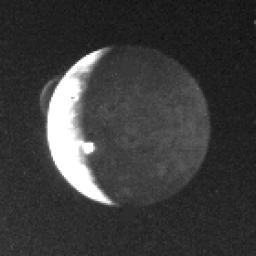 Voyager-2 became as close as possible to Jupiter on July 9, and although the most "tasty" went to his fellow man, and the operators held him at twice the distance from Jupiter (trying to take care of him) - the second device did not remain without discoveries: he discovered 3 new satellites and a new ring at Jupiter. According to the pictures of Io (with whom he approached only 1 million km), it was possible to establish that the surface of the satellite had changed, so that Io volcanoes continued to be active between the flights of the Voyagers. Pictures of Europe (taken from 206 thousand km) showed a surprisingly smooth surface of ice, broken only in some places by cracks. In total, the devices received almost 19 thousand pictures of Jupiter, its rings and satellites.
Voyager-2 became as close as possible to Jupiter on July 9, and although the most "tasty" went to his fellow man, and the operators held him at twice the distance from Jupiter (trying to take care of him) - the second device did not remain without discoveries: he discovered 3 new satellites and a new ring at Jupiter. According to the pictures of Io (with whom he approached only 1 million km), it was possible to establish that the surface of the satellite had changed, so that Io volcanoes continued to be active between the flights of the Voyagers. Pictures of Europe (taken from 206 thousand km) showed a surprisingly smooth surface of ice, broken only in some places by cracks. In total, the devices received almost 19 thousand pictures of Jupiter, its rings and satellites. Pictures of Europe taken by Voyager-1 interested scientists, and the cameras of the second apparatus sent me to examine its surface in more detail. But the data at that time was not enough to confirm the presence of a subsurface ocean in Europe, including this theory later went to confirm the Galileo spacecraft .
Pictures of Europe taken by Voyager-1 interested scientists, and the cameras of the second apparatus sent me to examine its surface in more detail. But the data at that time was not enough to confirm the presence of a subsurface ocean in Europe, including this theory later went to confirm the Galileo spacecraft .Rapprochement with saturn
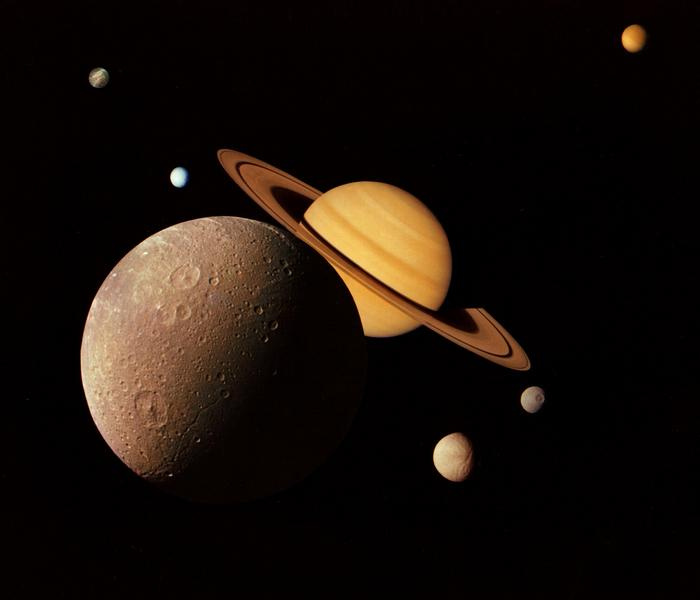 Saturn was a very cold but troubled planet: the temperature of the upper layers of its atmosphere was -191 ° C, and only at the north pole the temperature rose to + 10 ° C; but the winds raging there reached 1,800 km / h in the equatorial region. Pictures of Voyager-1 showed that the orbit of Enceladus passes through the densest areas of the rarefied Saturn E ring.But the most amazing object in the system turned out to be Mimas, from which the unit flew 88.44 thousand km: the 396-kilometer-wide satellite had surprisingly resembled with its 100-kilometer crater the Death Star from Star Wars (the V episode was released in only six months before the flight Voyager-1 Saturn):
Saturn was a very cold but troubled planet: the temperature of the upper layers of its atmosphere was -191 ° C, and only at the north pole the temperature rose to + 10 ° C; but the winds raging there reached 1,800 km / h in the equatorial region. Pictures of Voyager-1 showed that the orbit of Enceladus passes through the densest areas of the rarefied Saturn E ring.But the most amazing object in the system turned out to be Mimas, from which the unit flew 88.44 thousand km: the 396-kilometer-wide satellite had surprisingly resembled with its 100-kilometer crater the Death Star from Star Wars (the V episode was released in only six months before the flight Voyager-1 Saturn):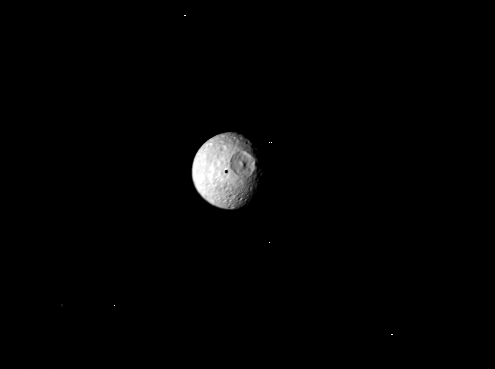 The last goal of Voyager-1 was Titan, who was considered the largest satellite in the solar system (at that time). The span of the apparatus, just 6490 km from its surface, produced almost sensational news: the updated estimates of its mass stated that Titan would have to give the crown of the largest solar system satellite in favor of Ganymede . But the Titan's atmosphere turned out to be even more of a surprise: on the contrary, it turned out to be denser than the calculated one, and together with estimates of its composition and temperature, this meant that lakes and seas from liquid hydrocarbons could exist on its surface.After Saturn, the paths of the vehicles diverged: a rapprochement with Titan was given to Voyager-1 at a great price — it went out of the ecliptic plane and could no longer continue to explore the planets. Fortunately, Voyager-1 played its role as “excellent”, so it was not necessary to redirect Voyager-2 to a meeting with Titan, and he set off (already alone) in the continuation of the “Big Tour”.The span of August 26, 1981, of Voyager-2 past Saturn also did not remain without discoveries: it turned out that the surface of Enceladus is very smooth and contains almost no craters (that is, it is very young). This ice surface provided Enceladus with the albedo record holder of the solar system (it was 1.38). This also provided the title of the “coldest” satellite of Saturn - the temperature there did not rise above -198 ° C even at noon.On close-up photography, the rings of Saturn fell apart into a myriad of small rings. There were so many of them that the head of the visualization team, Bradford Smith, abandoned them to be counted during the daily press conference and invited the reporters to do it themselves.
The last goal of Voyager-1 was Titan, who was considered the largest satellite in the solar system (at that time). The span of the apparatus, just 6490 km from its surface, produced almost sensational news: the updated estimates of its mass stated that Titan would have to give the crown of the largest solar system satellite in favor of Ganymede . But the Titan's atmosphere turned out to be even more of a surprise: on the contrary, it turned out to be denser than the calculated one, and together with estimates of its composition and temperature, this meant that lakes and seas from liquid hydrocarbons could exist on its surface.After Saturn, the paths of the vehicles diverged: a rapprochement with Titan was given to Voyager-1 at a great price — it went out of the ecliptic plane and could no longer continue to explore the planets. Fortunately, Voyager-1 played its role as “excellent”, so it was not necessary to redirect Voyager-2 to a meeting with Titan, and he set off (already alone) in the continuation of the “Big Tour”.The span of August 26, 1981, of Voyager-2 past Saturn also did not remain without discoveries: it turned out that the surface of Enceladus is very smooth and contains almost no craters (that is, it is very young). This ice surface provided Enceladus with the albedo record holder of the solar system (it was 1.38). This also provided the title of the “coldest” satellite of Saturn - the temperature there did not rise above -198 ° C even at noon.On close-up photography, the rings of Saturn fell apart into a myriad of small rings. There were so many of them that the head of the visualization team, Bradford Smith, abandoned them to be counted during the daily press conference and invited the reporters to do it themselves.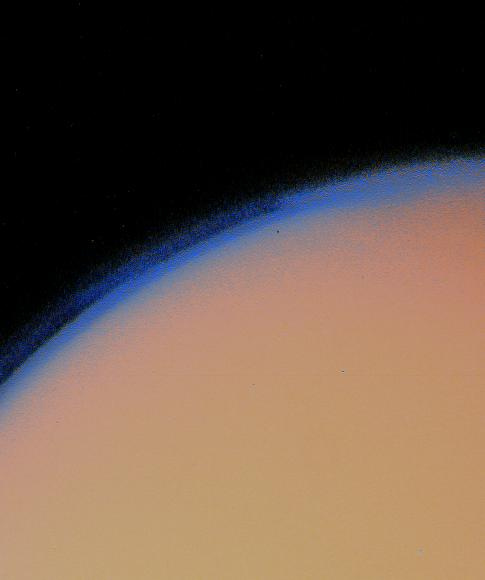 In total, about 16 thousand pictures of the system were obtained. After the flight of Saturn, the platform with scientific equipment was already stuck on Voyager-2. By some miracle, this happened after the flight of the Saturn system, and after only a couple of days, it was possible to establish that the platform reluctantly rotated when the engines were reinforced (apparently the lubrication was over), so that the Voyager-2 mission could be continued.
In total, about 16 thousand pictures of the system were obtained. After the flight of Saturn, the platform with scientific equipment was already stuck on Voyager-2. By some miracle, this happened after the flight of the Saturn system, and after only a couple of days, it was possible to establish that the platform reluctantly rotated when the engines were reinforced (apparently the lubrication was over), so that the Voyager-2 mission could be continued.Uranus, Neptune and beyond
For the purpose of speeding up communication with Voyager-2, Uranus has a 64-meter and two 26-meter plates DSN network connected into a single network. This was done for the first time to speed up data transfer, as the cameras of the device had to have time to take thousands of pictures of the Uranus system, and the memory of the device was only enough for a hundred of them, so the communication system turned out to be a bottleneck.Until the meeting of Voyager-2 with Uranus on January 24, 1986, practically everything that was known about him is that he rotates “on his side”, has 9 rings and 5 satellites (even the period of his conversion was unknown). During the flight of the device, the number of satellites increased threefold at once, and two new ones added to the rings, while they themselves turned out to be different from those of Jupiter and Saturn: the data indicated that they were younger than the planet and apparently formed as a result of the destruction of the satellites by tidal forces .The duration of the Uranian day was 17 hours and 12 minutes, and the climate was not at all hot: the average temperature in the atmosphere was -214 ° C and surprisingly maintained almost exactly over the entire surface, from the equator to the poles. But the most surprising discovery was that Uranus has a magnetic field 60 times larger than that of the Earth, which is about a third of the radius from the center of the planet, and deflected from the axis of rotation by as much as 60 ° (for Earth, this figure is only 10 °). This strange behavior has not previously been recorded in any body in the solar system.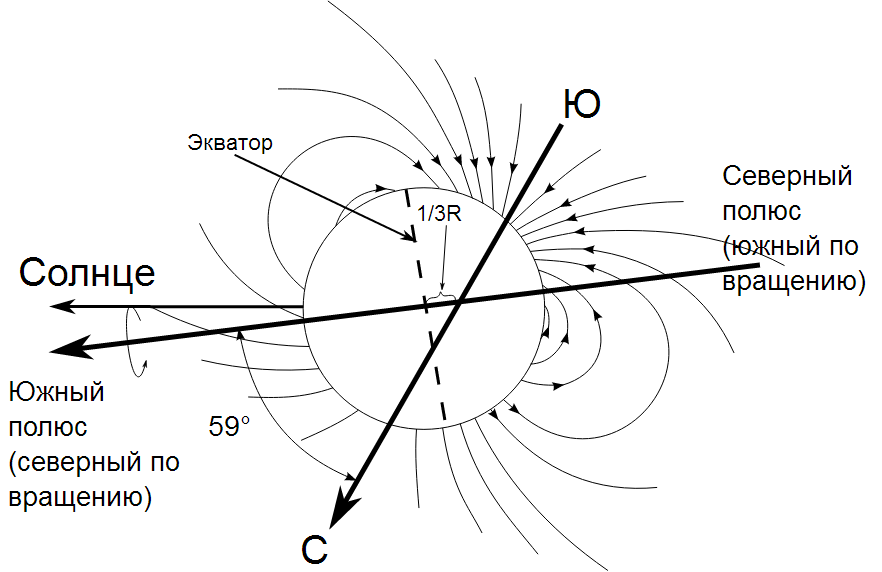 No less strange was the closest satellite of Juran - Miranda. This irregular satellite, only 235 km in diameter, had perhaps the most amazing surface among all the objects of the solar system: some areas of the satellite were densely dotted with craters, others almost did not have such, but were covered with networks of deep canyons and ledges. Everything on the surface of Miranda talked about the active and unusual geological history of the satellite:
No less strange was the closest satellite of Juran - Miranda. This irregular satellite, only 235 km in diameter, had perhaps the most amazing surface among all the objects of the solar system: some areas of the satellite were densely dotted with craters, others almost did not have such, but were covered with networks of deep canyons and ledges. Everything on the surface of Miranda talked about the active and unusual geological history of the satellite: In connection with the passing of the Voyager-2 passing by on August 25, 1989, these tricks were not enough, and the 64-meter DSN plates in Goldstone (California), Madrid (Spain) and Canberra (Australia) were upgraded to an impressive 70 meters, and 26-meter plates "grew up" to a diameter of 34 meters. Plate Upgrades at Goldstone
In connection with the passing of the Voyager-2 passing by on August 25, 1989, these tricks were not enough, and the 64-meter DSN plates in Goldstone (California), Madrid (Spain) and Canberra (Australia) were upgraded to an impressive 70 meters, and 26-meter plates "grew up" to a diameter of 34 meters. Plate Upgrades at Goldstone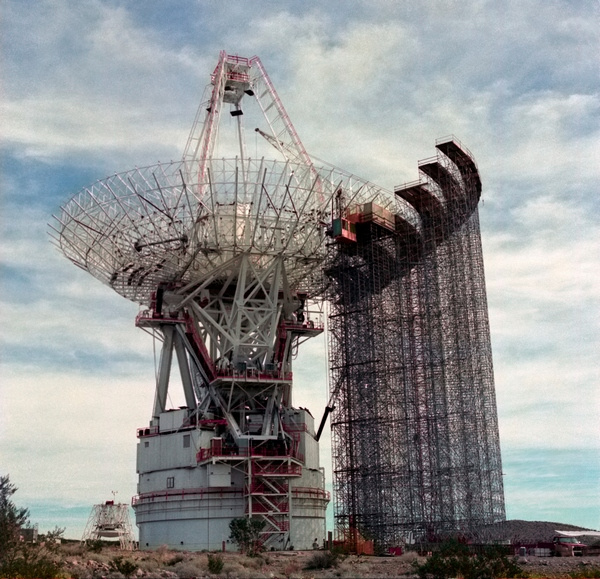
« - DSN » — DSN .
Neptune was the last planet with which Voyager-2 was to meet, so it was decided to go incredibly close to the planet - only 5 thousand km from its surface (it was less than three minutes of flight at the speed of the vehicle). And the data transmitted by the device was worth it: in the center of the photos of Neptune there was a “big dark spot” whose dimensions were 2 times the Earth, which was an atmospheric anticyclone. It was less than the big red spot of Jupiter, but it was still a record: the wind speed around the spot reached 2400 km / h!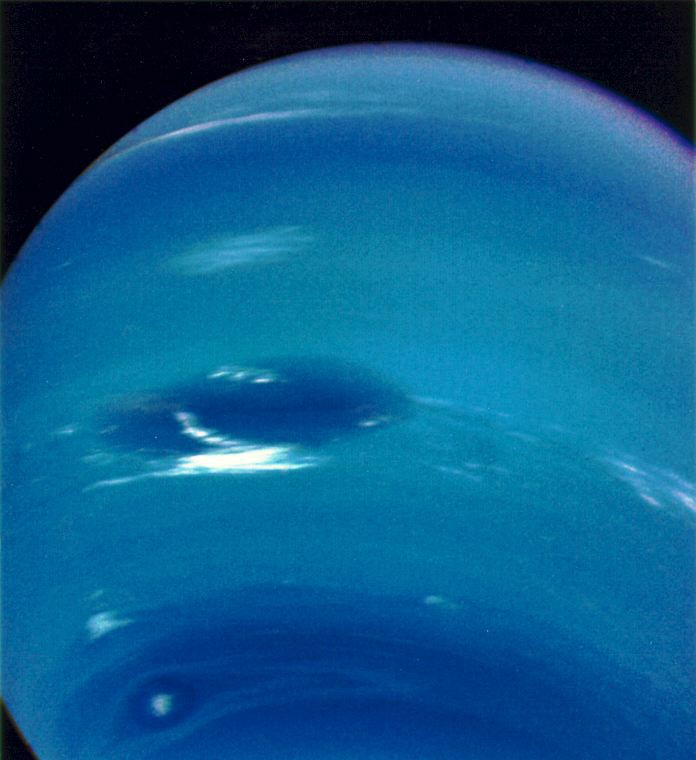 By the span of Neptune, the cost of the project reached $ 875 million, but $ 30 million for the first two years of the extended interstellar mission were allocated without hesitation, and the mission required the fourth emblem:
By the span of Neptune, the cost of the project reached $ 875 million, but $ 30 million for the first two years of the extended interstellar mission were allocated without hesitation, and the mission required the fourth emblem: The Voyager-2 cameras were permanently turned off on October 10 and December 5, 1989, and on February 14, 1990, Voyager-1 took his last shots, called the Family Portrait : they depict all the planets of the Solar System, with the exception of Mercury and Mars (light from which is too weak to be distinguished on the cameras). On the same day, the cameras and the second device were turned off. Shooting scheme: Among these photographs stands out a photograph of our Earth, which Karl Sagan specifically asked for over the years. It was from his hand that she received the name "pale blue dot" :
The Voyager-2 cameras were permanently turned off on October 10 and December 5, 1989, and on February 14, 1990, Voyager-1 took his last shots, called the Family Portrait : they depict all the planets of the Solar System, with the exception of Mercury and Mars (light from which is too weak to be distinguished on the cameras). On the same day, the cameras and the second device were turned off. Shooting scheme: Among these photographs stands out a photograph of our Earth, which Karl Sagan specifically asked for over the years. It was from his hand that she received the name "pale blue dot" :
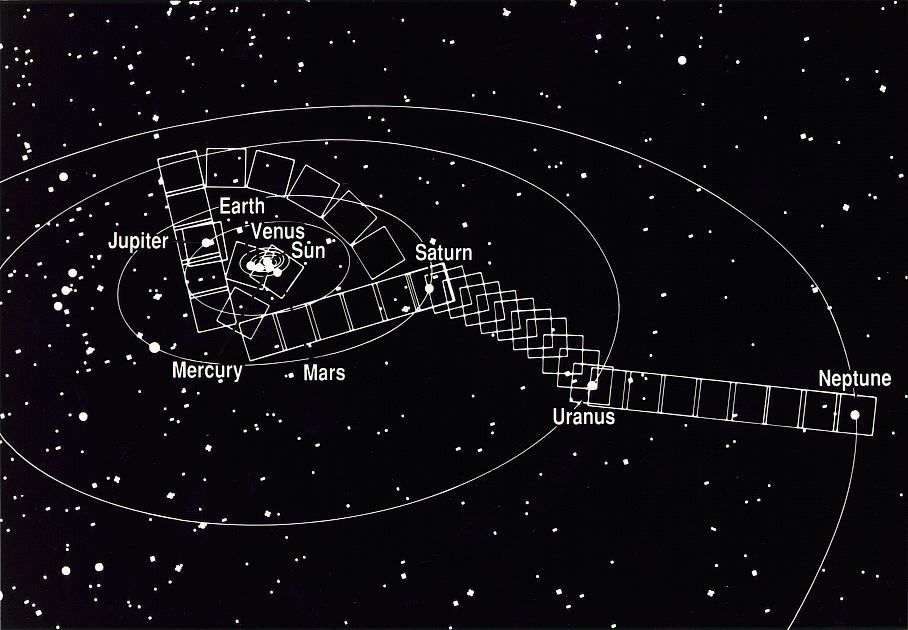
 The ground is on the red line to the right, below the center of the photo. The size of the earth in this photo is 0.12 pixels. The only reason why it is still somehow discernible is that it reflects enough light to be visible against the backdrop of the darkness of space.
The ground is on the red line to the right, below the center of the photo. The size of the earth in this photo is 0.12 pixels. The only reason why it is still somehow discernible is that it reflects enough light to be visible against the backdrop of the darkness of space.Speech by Karl Sagan, dedicated to this photo:Take another look at this point. It's here. This is our house. This is us. Everyone you love, everyone you know, everything you have ever heard of, everyone who ever existed lived their lives on it. Many of our pleasures and sufferings, thousands of self-confident religions, ideologies and economic doctrines, every hunter and gatherer, every hero and coward, every creator and destroyer of civilizations, every king and peasant, every couple in love, every mother and father, every capable child, the inventor and traveler, every teacher of ethics, every deceitful politician, every "superstar", every "greatest leader", every saint and sinner in the history of our species lived here - on a mote suspended in the sunbeam.
The Earth is a very small stage on the boundless space arena. Think of the rivers of blood shed by all these generals and emperors, so that, in glory and triumph, they may become short-term masters of a piece of grain. Think of the endless cruelties perpetrated by the inhabitants of one corner of this point over the barely distinguishable inhabitants of another corner. About how frequent the differences between them, about how they crave to kill each other, about how hot their hatred.
Our posturing, our imaginary significance, the illusion of our privileged status in the universe - they all succumb to this point of pale light. Our planet is just a single speck of dust in the surrounding cosmic darkness. In this great emptiness there is not a hint that someone will come to our aid in order to save us from ourselves.
Earth is the only known world that can sustain life. We have nowhere else to go - at least in the near future. Visit - yes. To settle - not yet. Whether you like it or not - Earth is now our home.
Astronomy is said to instill modesty and strengthen character. Probably there is no better demonstration of stupid human ignorance than this detached picture of our tiny world. It seems to me that she emphasizes our responsibility, our duty to be kinder to each other, to keep and cherish the pale blue dot — our only home.
Initially, project workers were afraid that Voyager cameras could be damaged due to the light of the Sun, which was too close to Earth from such a distance (Voyager-1 at that time was just 6 billion km from Earth) - the line itself in this photo is like times the glare from the sun. In 1989, the decision to take photographs was made, but the camera calibrations were delayed (since the DSN plates were busy retrieving information from Voyager-2 Neptune flying over). After that, there were problems with the fact that the Voyagers' camera control staff had already been transferred to other projects. The then head of NASA,
Richard Truly , even had to stand up for the idea of a “family portrait”.
February 17, 1998 Voyager-1 became the most distant object created by man, beating in this rank Pioneer-10. Unfortunately, the Pioneers-10 and 11 were not destined to transmit information about the boundaries of the solar heliosphere: the Pioneer-11 failed the solar sensor, due to which it was “lost” in space and could not support the direction of its sharply directed antenna to the Earth (this happened September 30, 1995 at a distance of 6.5 billion km). Pioneer 10 worked to the last of its reserves, but its weakening signal was ultimately unable to receive even huge DSN plates, and communication with it was lost on January 23, 2003, at a distance of 11.9 billion km.
In February 2002, Voyager-1 entered the
shock wave of the solar heliosphere, and on December 16, 2004 - crossed it for the first time among man-made vehicles. On August 30, 2007, his brother crossed it, and on September 6 a recording device was turned off on Voyager-2.
On March 31, 2006, a radio amateur from
Bochum (Germany) was able to obtain data from Voyager-1 using a 20-meter plate using signal accumulation techniques. Data acquisition was confirmed at the DSN station in Madrid.
August 13, 2012 Voyager-2 broke the record for the duration of the apparatus in space. It was a
Pioneer-6 record that worked for 12,758 days in space - although it is possible that it is still operational (they did not try to get in touch with it on December 8, 2000). Maybe some enthusiasts will decide to contact him, and he will regain the title of the most long-lived spacecraft? Who knows…
On April 22, 2010, problems with scientific data were discovered on Voyager-2. On May 17, JPL found out the reason for which the memory bit turned out to be in thyristor snapping state. On May 23, the software was rewritten so that this bit was never used.
On August 25, 2012, Voyager-1 crossed the heliopause (confirmations were obtained on April 9, 2013), and ended up in the interstellar medium. Voyager 2 should soon follow fellow and to this
"last frontier .
"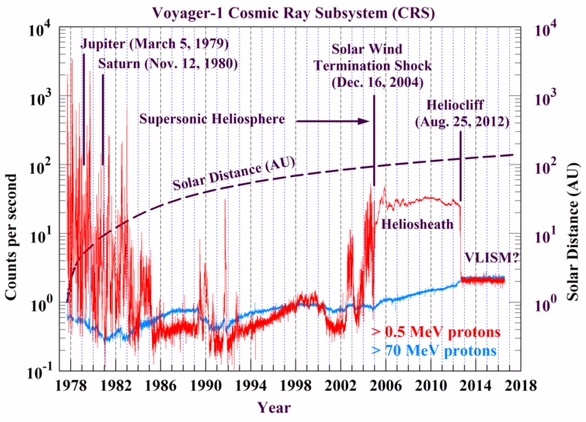
 Indications of the
Indications of the density of cosmic rays of Voyager-1 (above) and Voyager-2 (below).
As can be seen from the graphs, both Voyagers have already entered the solar layer separating the solar system from the interstellar medium, and Voyager 1 has already managed to get out of it. The peaks at the beginning of the graphs show increased radiation in Jupiter (associated with its active
satellite Io ), and Saturn. It was supposed (according to the initial 5-year mission) - that half of the radiation dose of the Voyagers would be received by flying Jupiter.
Current status
The original flight program calculated for five years - they have already exceeded 8 times (however, this is far from the current
Opportunity record 53 times, which still continues to work). Voyager speeds are 17.07 km / s and 15.64 km / s, respectively. Their mass (after using part of the fuel) is 733 and 735 kg. In the RTGs, about 73% of plutonium-238 remains, but the output power of the supply devices has decreased to 55% (taking into account the degradation of
thermoelectric generators ) and is 249 W of the original 450.
Of the original 11 instruments, only 5 remain on: these are MAG (magnetometer), LECP (low energy charged particle detector), CRS (cosmic ray detector), PLS (plasma detector), PWS (plasma wave receiver). On Voyager-1, periodically another UVS (ultraviolet spectrometer) is activated.
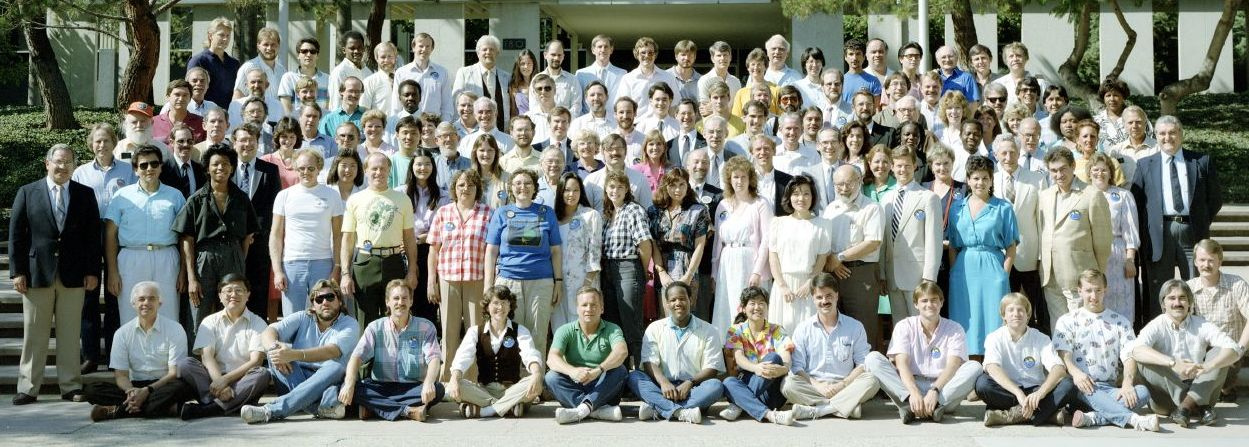
Members of the Voyager Mission on August 22, 2014
Future apparatuses
At the moment, the Voyagers team is fighting for the survivability of the vehicles, trying to carve out the maximum of the available energy for the operation of scientific instruments and their heaters. Best of all, this process is described by Suzanne Dodd:
"The developers say: 'this system consumes 3.2 watts." But in reality it consumes 3 watts, but they must be conservative in the design process when they build the machine. Now we are at that point of the mission when we are trying to get rid of excess reserves, and get real numbers. ”
In the near future, gyroscopes should be turned off on the devices, and from 2020, we will have to start disabling some of the scientific instruments. The team members do not yet know how they will behave in the conditions of the wild cold of space (as spare devices, and even their individual instruments, which could be checked in the pressure chamber, have not survived on Earth). Perhaps the devices will remain operational in the process of turning off their heaters, and then the time to turn off the last devices will be delayed from 2025 to 2030.
It is estimated that Voyager 2 must go beyond the heliosphere within a decade. The exact date cannot be named as the heliosphere is not ideally spherical, but elongated under the action of external forces of the
interstellar medium . So Voyager-2 should have enough time to get out of the shock wave in order to start studying the interstellar substance (at a point different from its fellow) and make with it perhaps not even its last discovery - the shape of the solar heliosphere.
Voyager 1 should be one day away from Earth by 2027, and Voyager 2 by 2035. After 2030, the devices will go into radio beacon mode (without the power to support the operation of their devices) and will work until 2036, after which they will be silent forever. Thus, the apparatuses must "retire" at the age of 48-53 years, and they must "survive" to the age of 59 years.
Voyager-1 is sent to a point
with coordinates of 35.55 ° ecliptic latitude, and 260.78 ° ecliptic longitude, and after 40 thousand years to get close to 1.6 St. years with the star
AC +79 3888 Giraffe constellation (this star, in turn,
moves closer to the Sun, and at the time of the passage of Voyager-1 will be at a distance of 3.45 lbs. years from us). At about the same time, Voyager-2 (moving in the direction of -47.46 ° ecliptic latitude, and 310.89 ° ecliptic longitude), will approach the star
Ross 248 at a distance of 1.7 St. year, and after 296 thousand years from now, fly by 4.3 of St. years from
Sirius .
Project Manager

1972 in Caltech, and 2017 for
an interview at KAUST University
Edward Stone - the permanent project manager who began his career in astrophysics with experiments on the study of cosmic rays in 1961. From 1967 he became a full teacher of Caltech, in 1976 he was a professor of physics, and from 1983 to 1988 he was the chairman of the department of physics, mathematics and astronomy at this institute. From the late 80s to 2007 he was the chairman of the board of directors of
the Keck Observatory . In 1991-2001, he served as the head of JPL, in 1996, asteroid No. 5841 was named after him. Now he continues to be the executive director of the
thirty-meter telescope , and the teacher of
Caltech (which he has been already since 1964).
Awards1991 - National Medal of Science
1992 - Magellanic Premium
1999 - Carl Sagan Memorial Award
2007 - Philip J. Klass Award for Lifetime Achievement
2013 - NASA Distinguished Public Service Medal
2014 - Howard Hughes Memorial Award
Afterword

“We have always been in the same waiver of losing the mission,” says Susanna Dodd
These devices launched at the time of the release
of the 4th episode of “Star Wars” and
“Close contacts of the third degree” - experienced dozens of faults and 40 years of being in vacuum at a temperature slightly above absolute zero. Many times their mission was questionable - even before their immediate launch. And no matter what, they still remain in the ranks. Perhaps as a hymn to the mission you can’t find anything better than the favorite composition of Mark Watney from the
novel “The Martian” ) -
“Stayin 'alive” Bee Gees:
References:
Current mission
status (distance and speed relative to the Earth, sensor readings)
The current state of the DSN (who you are currently communicating with).
Cosmic ray
dataPhotos of devices and pictures taken by them
Detailed article about devices on galcpase.spb.ru
Description of the device design
Description of the computing system
Description of communication systems of some scientific missions (including Voyagers)